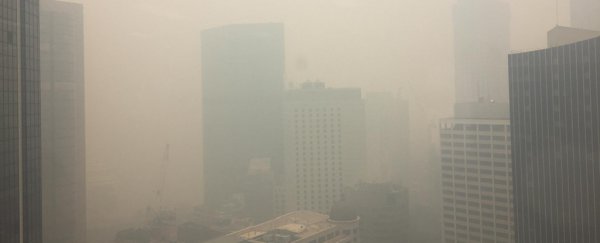Australia is on fire. For several weeks, unprecedented fire conditions have torched around 2.7 million hectares in the eastern states - almost three times more than what was lost in the 2019 Amazon fires. Worryingly, the danger spreads far beyond the immediate path of the flames.
On Tuesday, giant smoke clouds produced by the rampant bushfires saw air pollution in Sydney spike to over 12 times the 'hazardous' level, as the city choked under a toxic blanket the likes of which few have ever witnessed.
"Certainly in Sydney we have experienced very poor air quality episodes in the past and the one I'm most aware of is the 2009 dust storm episode, where we had extremely high levels," NSW director of environmental health, Richard Broome, told media.
"But certainly this smoky period we've been experiencing for the past month or so, it is unprecedented, so these conditions are a risk to people's health."
Bushfire smoke over Manly Beach, Sydney this morning.
— theloneisobar (@DeanSgarbossa) December 10, 2019
📸 Lawrie Wilson#AustraliaBurns #sydneysmoke #bushfiresNSW #bushfires #sydneyfires #sydney #australia #australiafires pic.twitter.com/vTY7F14wMf
Under the Air Quality Index (AQI), which measures pollution levels in the air, readings of 100 to 149 are considered poor, 150 to 199 rates as very poor, and measurements of 200 or above are deemed hazardous to health.
On Tuesday, several regions in Sydney rated above 400, some scored over 1,000, and at least two breached the 2,000 AQI threshold, with the inner west suburb of Rozelle, only a few kilometres west of the city centre, recording a phenomenal AQI reading of 2,552, almost 13 times the hazardous level.
"This was a significant event," environmental scientist Mark Taylor from Macquarie University told The Sydney Morning Herald. "These air quality readings are only seen in places like India and China and they're pushing the limits (of those places)."
See the Sydney smoke haze go from bad to worse today, making it virtually impossible to see the Sydney Harbour Bridge. #SydneySmoke pic.twitter.com/Rzh0iV6C9i
— Nine.com.au (@Ninecomau) December 10, 2019
"It's not a local event, it's enormous, exposing 4 to 5 million people (to bushfire smoke), which we know is carcinogenic," Taylor added. "It's inescapable, we're living in a sea of smoke and particles."
Amid the hellish smoke scenes – dubbed the 'airpocalypse' – hospital admissions increased, public transport was disrupted, smoke alarms prompted building evacuations, and residents scrambled to buy face masks to afford themselves a better chance of protection from inhaling particles carried in the haze.
Antonio and Paula’s wedding day - in front of the most iconic backdrop in #sydneysmoke pic.twitter.com/jRwm32EqmA
— ANDREW THOMAS (@and_thomasComms) December 10, 2019
Australia's conservative Prime Minister Scott Morrison has attracted sharp criticism from many for downplaying the well-known link between climate change (not to mention his country's hand in it) and the ongoing bushfire crisis. While fires are not directly attributable to the changing climate, extremely dangerous fire conditions are fuelled by rising temperatures and intense droughts.
Meanwhile, media reports indicate that face masks are likely to become a common accessory on city streets.
The charCOAL coast. #NSWbushfires #ClimateChange #waterquality #sydneysmoke pic.twitter.com/1TMi0cBhK0
— Prof Emma L Johnston AO FAA FTSE (@DrEmmaLJohnston) December 8, 2019
Outside the city, close to 700 homes have been destroyed, and untold wildlife has been slayed, including entire koala populations. In Sydney, one resident summed up the bleak byproducts of the crisis about as astutely as anybody could.
"Coughing in bed, choke on the smoky air," journalist Andrew Thomas tweeted. "A Manly ferry emerges from the gloom. And a man wears a gas mask on the ferry. And this is a horrible new normal."
